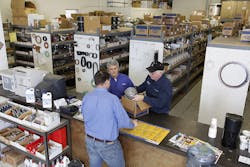Clearly, having an available supply of parts in inventory is important to any vehicle and equipment maintenance operation. Yet, poor inventory management practices often end up wasting money.
One way to get a grip on parts expenses is to calculate the inventory carrying cost, also called inventory cost of ownership.
To determine the cost to stock a part, we have to look at the entire range of costs associated with ownership. You stock parts not because you want to, but to reduce the downtime of your fleet and to maintain the productivity of your staff.
Stock
There are several types of stock. Some items, such as filters, are stocked as a convenience to the technicians.
Other items might be hard-to-get parts. These are stocked to manage the risk of downtime. A city or town without the use of its fire trucks, for example, creates an unacceptable risk.
Certainly, if you had a heavy duty distributor next door, you would find it makes no economic sense to hold much stock, especially if the distributor’s hours coincide with your repair facility hours.
True Part Cost
Cost of ownership accumulates all the costs of owning the parts. If you added a profit, these would be the same costs as opening a truck parts retail shop.
What is the true cost of an item in your inventory? Let’s assume you currently have $1,000,000 worth of parts on shelf.
|
ITEM TO BE CHARGED |
SAMPLE |
|
Cost of money
|
6 percent of $1,000,000 = $60,000 |
|
Cost of warehousing, including heat, light, power, phone, utilities |
$12/sq’/yr: 4,000’= $48,000 |
|
Cost of airfreight and expedited shipments over and above standard charges |
$36,000 |
|
Cost of real estate taxes, asset taxes and insurance on building and inventory |
$6,000 |
|
Salaries of storeroom personnel, including manager and part-timers |
$74,000 |
|
Cost of deterioration, shrinkage, obsolescence, returns and restocking fees |
$72,000 |
|
Pickup or utility truck (all costs) for field service calls |
$12,000 |
|
Other costs, including office supplies, computer hardware and software, tools, banding, shrink wrap, depreciation on equipment (use 10 percent) |
$12,000 |
|
Cost of open bin items, maintenance supplies, all items issued without a work order. |
$11,000 |
Total of all expenses: $271,000
Total of all issues for year: $1,000,000 (1 turns)
Inventory carrying costs (I) ratio equals total expenses divided by total issues ($271,000 divided by $1,000,000 equals 27 percent).
To convert a part cost to part charge-out, multiply the part cost by 1, plus 1. In our example, the true cost of the item is 1.2 (unit cost).
|
PART |
CURRENT ESTIMATED COST |
I RATIO |
CHARGE OUT RATE (should be the cost used in the parts charge-out on the work orders) |
|
Battery |
$138 |
1.2 |
$165 |
|
Alternator |
$765 |
1.2 |
$918 |
|
Tire (supplied as needed by contractor) |
$524 |
No factor (since not in inventory) |
$524 |
|
Tire (from stock) |
$524 |
1.2 |
$629 |
Joel Levitt is director of international projects for Life Cycle Engineering (www.lce.com), an organization that provides consulting, engineering, applied technology and education solutions that deliver lasting results. Previously, he was president of Springfield Resources (www.maintenancetraining.com), a management consulting firm.
About the Author

Joel Levitt
President, Springfield Resources
Joel Levitt has trained more than 17,000 maintenance leaders from more than 3,000 organizations in 24 countries. He is the president of Springfield Resources, a management consulting firm that services a variety of clients on a wide range of maintenance issues www.maintenancetraining.com. He is also the designer of Laser-Focused Training, a flexible training program that provides specific targeted training on your schedule, online to one to 250 people in maintenance management, asset management and reliability.
